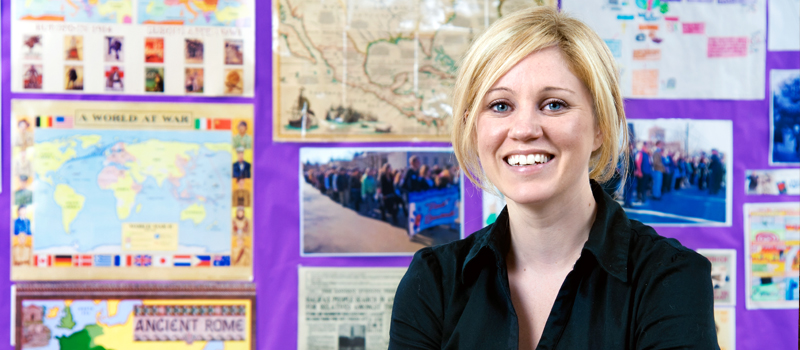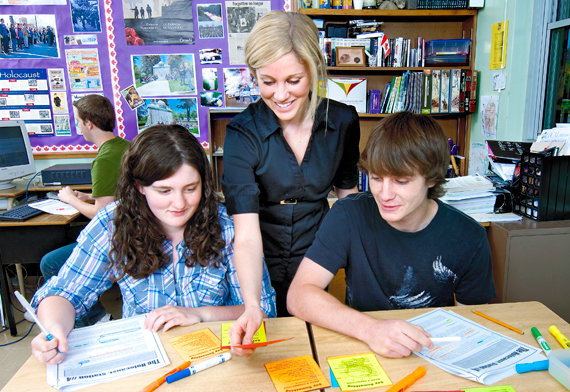
Lindsay Hall, OCT
Using new media for old stories
by Leanne Miller, OCT
How do you make historians out of video game players who would rather watch movies? How can you teach the readers of comics that turn historical events and figures into fictional legends to turn a critical eye on historical sources?
Lindsay Hall, OCT, has found a way to engage Grade 10 students who think history is boring, especially when it comes from a textbook. Instead of saying “no” when students ask to watch Saving Private Ryan or play Medal of Honor: Frontline, Hall incorporates them into her World War II summative task. Students create their own historically accurate comic books about Canadian participation in the war.
Hall, now head of history at Clarke Road SS in London in the Thames Valley DSB, is one of seven recipients of a 2009 Governor General’s Award for Excellence in Teaching Canadian History, as chosen by Canada’s National History Society.
The award citation praises Hall’s summative task, Historical Sources for the 21st Century: Significant Canadian World War II Battles and Contributions, which she developed while teaching at Huron Park SS in Woodstock. It embraces the media that interest today’s teens and gives them authentic learning opportunities. Using video games, feature and documentary films, graphic novels, newsreels and slide presentations, students progress through a variety of lessons and work stations to learn about the role Canadians played in Hong Kong, Dieppe, the Battle of Britain, the Italian Campaign, the war in the air and at sea, D-Day, and the liberation of the Netherlands.
Students gain in-depth knowledge of a significant Canadian battle or contribution to World War II by applying their knowledge and skills to create a final product that takes the form of a movie, children’s book or comic. Hall expects the final products to be professional and useful historical sources for future classes.
The entire class then shares its work as a gallery tour. Hall explains that the gallery tour format gives students an opportunity to showcase their work and enjoy what their classmates have created. Chatting to a small group of classmates also supports those students who are intimidated when they have to speak in front of a large group. And it allows students to review the significant historical content from the unit’s enduring understandings.
By varying my approach and adjusting the content, process and product based on students’ needs, I can improve their learning experience.
Best of all, Hall reports that her students enjoy both the activity and
learning about Canadian history.
“By using media familiar to today’s youth,” Hall explains, “I teach my
students to think critically and analytically about the information they
see. These are skills they will use long after they leave my history classroom.”
Cody, Zach and Hunter were all in Hall’s Grade 10 applied class two years ago, and all took history with her again last year – the optional World History to the 16th Century (CHW3MI).
Cody says, “She makes it easier to understand than if we were working straight from the textbook. She knows we all learn differently, and she gives us choices – mind map, cause and effect, T-chart. We all learn, but we learn in the way that suits each of us best.”
When Hall first began teaching history in 2004, students asked her to let them watch feature films related to what they were studying. Hall was reluctant because the films available are often what she calls “glorifications, manipulations and Americanizations of our past.”
She soon realized that feature films like Saving Private Ryan, Swing Kids and The Boy in the Striped Pyjamas were the sources her students were learning from outside the classroom. They certainly weren’t reading history textbooks in their free time, she says, laughing. These films were informing students’ understanding of historical events.
“Therefore,” Hall says, “it made sense to embrace feature films and teach my students how to evaluate the reliability, accuracy and historical authenticity of these sources.”
Like many teachers, Hall knows that student engagement supports student success. And student success lies at the heart of her teaching philosophy. Her work on her board’s task force on differentiated instruction (DI) and assessment has greatly informed her teaching practice, along with a key Ministry initiative.
“In Ontario, Support Student Success and Learning to 18 is a reality,” Hall comments. “It’s our responsibility to make the education system work for all students, including those not heading for university after graduation.”

Lindsay Hall consults on a student project.
One of Hall’s key strategies is providing authentic educational experiences that consider students’ interests while also acknowledging their readiness and learning preferences.
“My DI work has taught me that by varying my approach and adjusting the content, process and product based on students’ needs, I can improve their learning experience and maximize opportunities for success.”
Hall designs lessons and units that allow for visual, auditory, kinesthetic and tactile learning opportunities. She reports that students feel safe and successful when completing tasks that correspond to their learning preference. Equally important, they develop their comfort level and ability when branching out from their preferred style.
Student Hunter agrees, although phrasing it differently: “She’s flexible. If we need an extra day or two, she’s cool, as long as we don’t take advantage and we get all of our work in. She puts herself in our shoes.”
Hall’s award-winning summative activity reflects her philosophy and experiences, and it also reflects her position on what she calls the skills-versus-content debate.
While she knows it’s important for her students to acquire an understanding of 20th-century Canadian history, Hall contends that content cannot be taught at the expense of skills such as critical thinking, source evaluation and research strategies.
At the beginning of every new semester, Hall surveys her students to find out their learning preferences and favourite subjects. Her Grade 10 students studying at the applied level often cite history as their least favourite subject. But by making her teaching relevant, visual, meaningful and interesting, and by focusing on the skills associated with the study of history, Hall changes many minds. Most of her students develop what she calls an appreciation for and genuine interest in Canadian history while they are in her class.
Student Zach says, “She makes us want to work and do well – for ourselves but for her too. She cares about us as people, not just as students in her classroom, and we don’t want to let her down. We start with fun, and then we take baby steps with the history to make sure we get it. Then it gets harder, but we can follow along. She brings history to life for us.”
And yes, they play Medal of Honor: Frontline on Hall’s PlayStation 2 and watch the 24-minute opening sequence of Saving Private Ryan.
The culminating task
Lindsay Hall is in a new school and classroom this fall and is meeting new groups of students. She will take the time to get to know her students on various levels: as learners, teenagers and members of the community. Hall will use a range of tools, including documents she has gathered as part of her board’s Differentiated Instruction Task Force, to help with student learning profiles.
“I need to know students’ learning preferences to construct individual learning profiles and a class profile, which will help guide my instruction and allow me to develop lessons that reflect students’ needs, styles and modalities. I also want to know what interests them, where they struggle and where they shine in their classes. Asking students to describe a time when they felt most successful in school often reveals a lot about their educational experiences.”
Hall talks about lessons, units and course design. “I start with the enduring understandings and critical learning skills that students must acquire in each of my classes. Then I use a backward design approach and develop summative assessment activities to allow students to demonstrate their acquisition of the necessary skills and knowledge at the end of each unit. This leads to the culminating task, which puts all of these pieces together.”
An outline of Hall’s culminating task for CHW 3M1 is available online.
Additional Information
Canada’s National History Society presents the Governor General’s Awards
for Excellence in Teaching Canadian History. Six teachers are chosen annually
to receive a medal and $2,500. In addition, the recipients’ schools each
receive a prize of $1,500.
For more information visit www.historysociety.ca or call the Governor General’s Awards for Excellence in Teaching Canadian History hotline at 1-800-861-1008.
Resources
- For Comic Life software, visit comiclife.com.
- For the Thames Valley DSB’s Learning Classroom Program Differentiated Instruction and Assessment, go to www.tvdsb.ca.